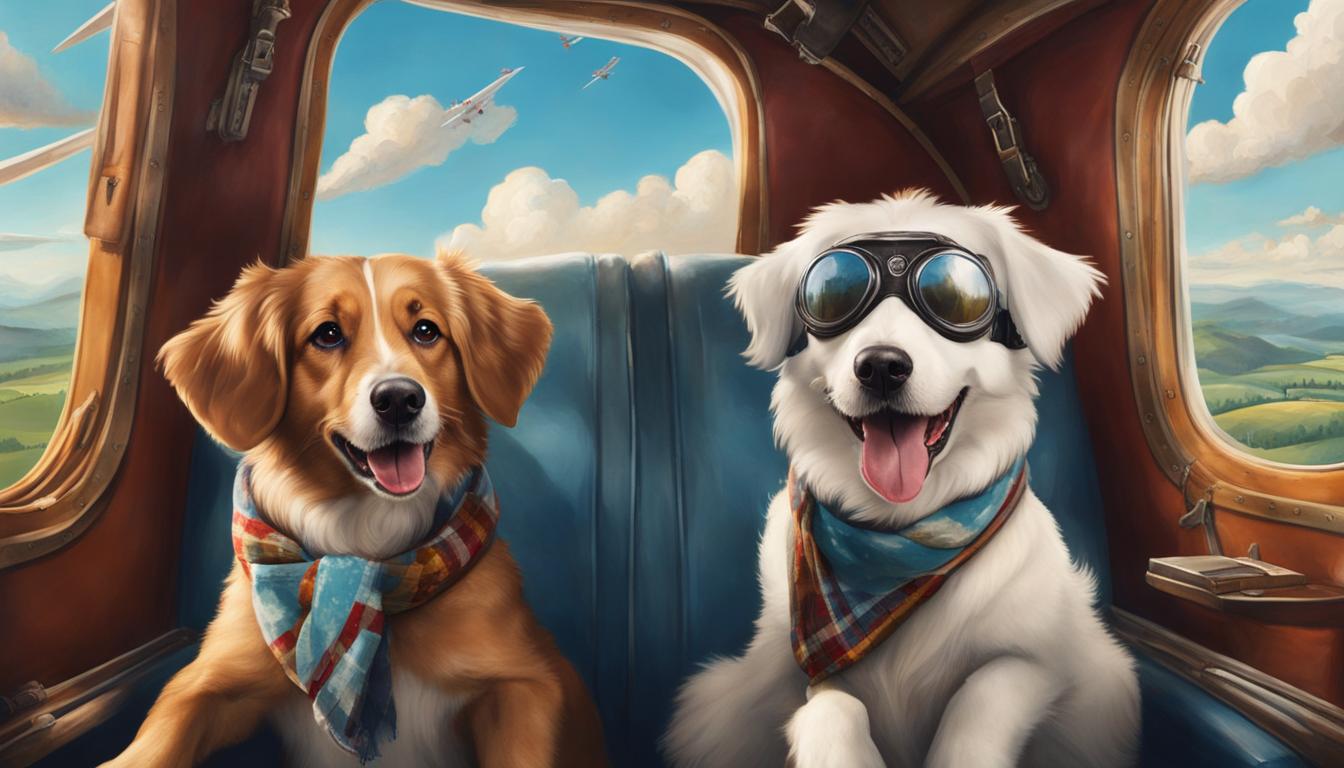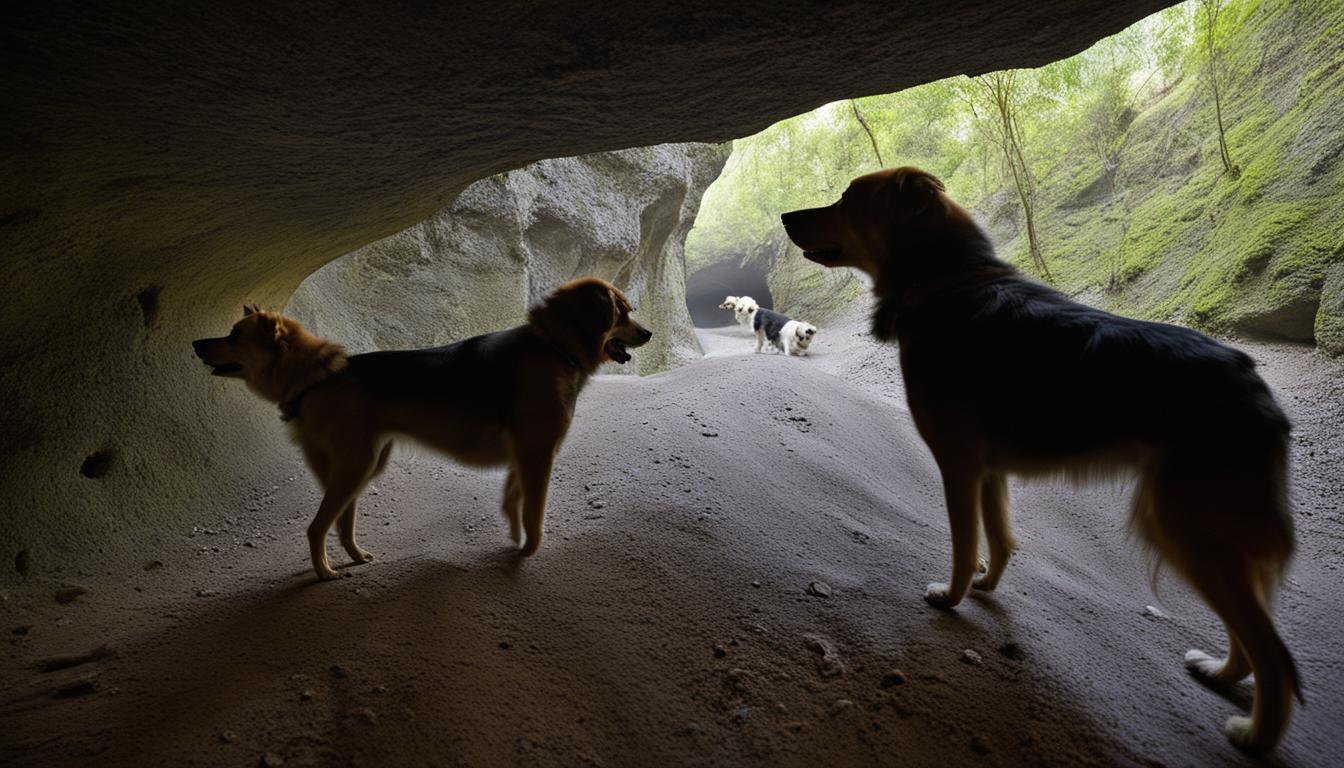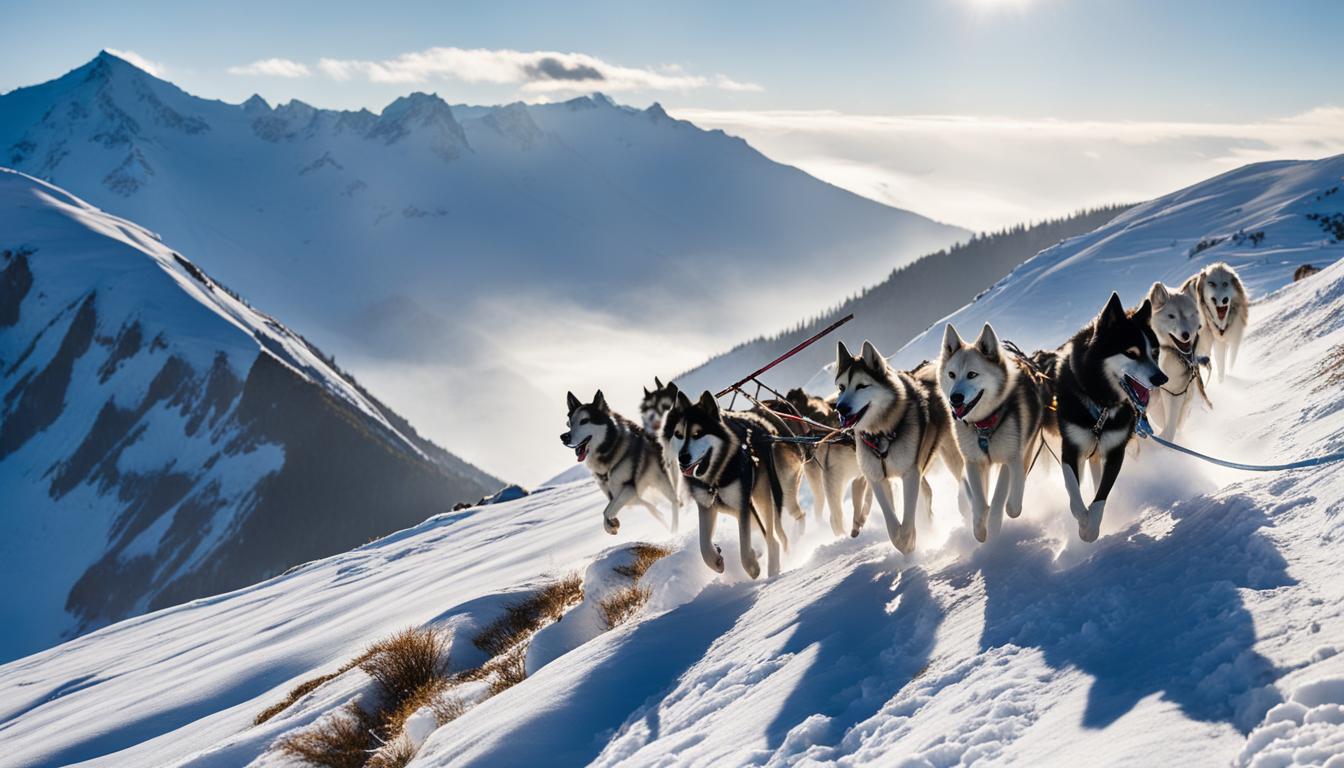Did you know that dogs played a crucial role in early 20th-century flights? These canines accompanied early aviators, providing assistance and support during the dawn of air travel. Their contributions often go unnoticed, but they played a vital role in ensuring the safety and success of these historic flights.
Whether it was as companions, navigators, or rescue helpers, these incredible dogs were selected for their unique abilities and served as trusted companions in the skies. They helped calm nerves and provided support during challenging flights, playing an integral part in the early days of aviation.
Key Takeaways:
- Dogs accompanied early aviators in early 20th-century flights.
- They provided assistance and support during the early days of aviation.
- Canines served as companions, navigators, and rescue helpers.
- Their presence helped calm nerves and provided support during challenging flights.
- These unsung heroes played a vital role in the safety and success of early aerial travel.
The Role of Dogs in Early Aviation History
The early days of aviation brought forth numerous challenges for pilots as they ventured into the skies. Among the many sources of support and companionship, dogs played a significant role in ensuring the success and safety of these early airplane journeys. These loyal canines aided early pilots in various ways, serving as invaluable companions, navigators, and even rescue helpers.
One of the key contributions of dogs in early aviation was their ability to provide comfort and calm to aviators. The high-risk nature of early flights often caused anxiety and nervousness among pilots, and having a loyal dog by their side helped alleviate some of these emotions. The presence of a canine companion provided a source of stability and reassurance, boosting the confidence of pilots as they embarked on their flights.
Furthermore, dogs proved to be excellent navigators, assisting pilots with their keen sense of direction and spatial awareness. Their advanced olfactory senses and natural homing instincts allowed them to help determine locations and navigate through challenging aerial terrains. Their acute senses also made them valuable assets in search and rescue operations during early aviation, as they could detect the presence of stranded individuals even from great heights.
As the field of aviation continued to evolve, so did the role of dogs in supporting pilots and aiding in aerial rescue missions. These remarkable creatures adapted to changing circumstances and worked alongside human rescuers, showcasing their unwavering loyalty and dedication. The contributions of dogs in early aviation history cannot be underestimated, and their presence remains a testament to their unique qualities and the bond they shared with early pilots.
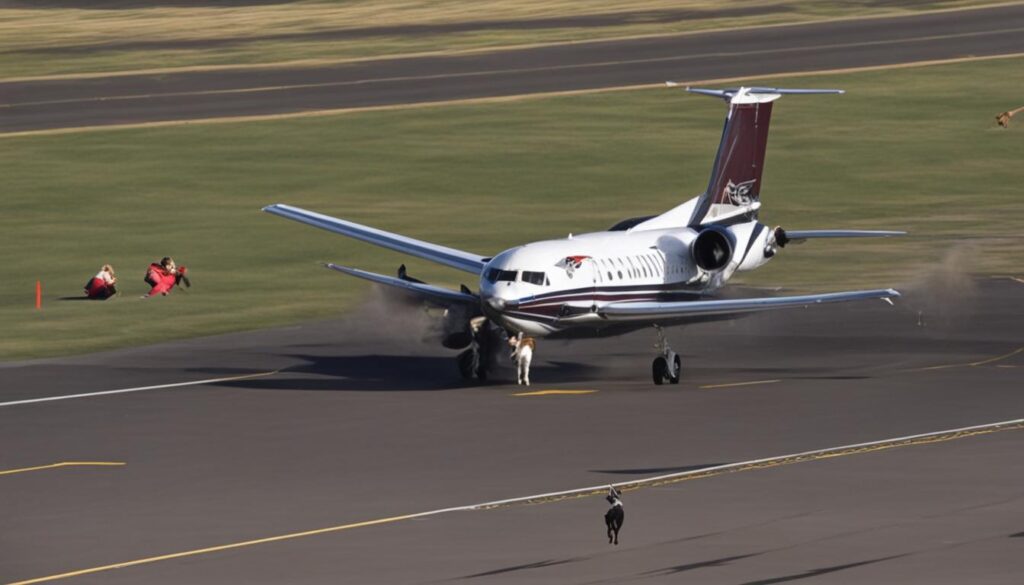
The Importance of Canine Companionship
“A dog is the only thing on earth that loves you more than he loves himself.” – Josh Billings
The quote above perfectly captures the essence of the relationship between early pilots and their canine companions. Dogs provided not only practical assistance but also emotional support to aviators during their pioneering flights. Their unconditional love and loyalty created a lasting bond that helped pilots navigate the challenges of early aviation.
Table: Dogs’ Contributions in Early Aviation
| Role | Contribution |
|---|---|
| Companionship | Provided emotional support and helped ease anxieties |
| Navigation | Assisted pilots in determining locations and navigating difficult terrains |
| Rescue Operations | Aided in search and rescue missions, detecting stranded individuals |
The table above summarizes the key contributions of dogs in early aviation. Their presence, whether as loyal companions or skilled navigators, played an integral role in the success and safety of early pilots. These remarkable canines exemplified the importance of teamwork and the powerful bond between humans and animals.
The Dawn of Air Exploration: Dogs in Early Aerial Search and Rescue
Dogs played a significant role in early 20th-century aviation, not only serving as companions and navigators but also as invaluable assets in search and rescue missions. Their unique abilities and unwavering loyalty made them indispensable in locating and rescuing individuals in distress during the dawn of air exploration.
Trained to use their keen sense of smell and cover large areas quickly, these canine heroes worked alongside human rescuers to save lives. With their exceptional tracking abilities, they could locate missing persons and provide critical support during emergency situations, even in remote and challenging terrain.
“Dogs have an extraordinary capacity to detect scents and locate individuals in distress, making them ideal partners in early aerial search and rescue operations,” says Dr. Emma Sullivan, a canine behavior expert. “Their dedication and commitment to the task at hand were unparalleled, often working tirelessly to reunite families and bring hope to those in need.”
The early aviation dog handlers recognized the importance of proper training to ensure the dogs’ effectiveness in search and rescue missions. Breeds with herding, hunting, or working backgrounds were selected for their focus, agility, obedience, and love of work. Through intensive training, these dogs developed the skills necessary to excel in their roles, becoming essential members of early aviation teams.
| Dog Breed | Air Rescue Qualities |
|---|---|
| German Shepherd | Highly trainable, excellent tracking instincts |
| Border Collie | Exceptional agility, quick problem-solving abilities |
| Newfoundland | Strong swimmers, adept at water rescues |
| Golden Retriever | Gentle and friendly disposition, easily bonded with rescued individuals |
As technology advanced and new methods for locating and rescuing people were developed, the role of dogs in aerial rescue continued to evolve. However, their legacy as pioneers in early air exploration and search and rescue operations remains significant, serving as a testament to their remarkable abilities and unwavering commitment.

Notable Early Aviation Dog Breeds
Several dog breeds stood out for their exceptional contributions to early aviation. These breeds were known for their intelligence, agility, and ability to remain calm under pressure:
- German Shepherds: Renowned for their versatility and trainability, German Shepherds were often used as aviation dogs due to their loyalty, courage, and strong work ethic.
- Border Collies: Known for their exceptional herding skills, Border Collies were valued for their intelligence, agility, and ability to follow commands with precision.
- Golden Retrievers: These friendly and intelligent dogs were well-suited for aviation roles due to their calm demeanor and strong sense of responsibility.
- Belgian Malinois: Resilient and highly trainable, Belgian Malinois were often chosen for their agility, endurance, and ability to excel in high-pressure situations.
These breeds, among others, made significant contributions to early aviation, demonstrating their adaptability and dedication as trusted companions in the skies.
The Evolution of Canine Roles in Aerial Rescue
As technology advanced and new methods for locating and rescuing individuals were developed, the role of dogs in aerial rescue underwent a significant evolution. These loyal and highly trained canines continued to play an important part in these efforts, adapting to changing circumstances and working alongside human rescuers.
One notable aspect of the evolution was the development of specialized search and rescue dog teams. These teams consisted of highly trained handlers and dogs with specific skills, such as scent tracking or water rescue. Working together, they formed an efficient and effective unit that could quickly locate and assist those in need.
In addition to their search and rescue capabilities, dogs also played a vital role in providing comfort and support to survivors. The presence of a friendly and familiar canine companion during times of distress offered emotional solace and helped alleviate anxiety. The dogs’ calming influence created a sense of security and reassurance, allowing survivors to feel more at ease during their rescue and recovery.
| Role | Evolution |
|---|---|
| Scent Tracking | The development of new training techniques allowed dogs to become even more adept at scent tracking, enabling them to locate individuals in challenging and diverse environments. |
| Water Rescue | With specialized training and equipment, dogs became capable of assisting in water rescues. Their natural swimming abilities and strong sense of teamwork made them valuable assets in these situations. |
| Emotional Support | The recognition of the dogs’ ability to provide emotional support led to increased focus on their role in comforting survivors during rescue operations. This led to the implementation of programs specifically aimed at pairing dogs with individuals in need of emotional support. |
The evolution of canine roles in aerial rescue demonstrates the valuable contributions these extraordinary animals have made throughout history. Their unwavering dedication, adaptability, and loyalty continue to make them indispensable companions in the ongoing mission to save lives.
Dogs in Early Aerial Travel: Uncovering their Unseen Contributions
While dogs were integral to early aerial travel and served as faithful companions to aviators, their handlers faced several challenges in managing their canine helpers.
The Cost of Training and Maintenance
One of the primary challenges faced by early aviation dog handlers was the cost associated with training and maintaining their dogs. The rigorous training required to develop the necessary skills for aerial travel was both time-consuming and expensive. Additionally, caring for the dogs during flights, including providing proper food and medical care, added to the overall expenses.
The Physical and Emotional Toll
Handling dogs in early flights took a toll on the physical and emotional well-being of the aviators. The demanding nature of their work, including long hours of training and flights, often resulted in fatigue and exhaustion. Moreover, the emotional bond formed between aviators and their canine companions made it difficult for handlers to cope with any mishaps or accidents that occurred during flights.
Adapting to the Unique Challenges
Despite these challenges, early aviation dog handlers were dedicated to their roles and found ways to overcome obstacles. They developed innovative training methods to ensure the dogs’ safety and well-being during flights. Additionally, support networks were established among handlers to share best practices and provide emotional support.
| Challenges | Solutions |
|---|---|
| The cost of training and maintenance | Establishing fundraising initiatives to cover expenses |
| The physical and emotional toll | Offering counseling and support for handlers |
| Adapting to the unique challenges | Sharing knowledge and experiences through networks |
Despite the challenges faced by early aviation dog handlers, their unwavering dedication to their canine companions enabled them to overcome obstacles and contribute to the success of early aerial travel.
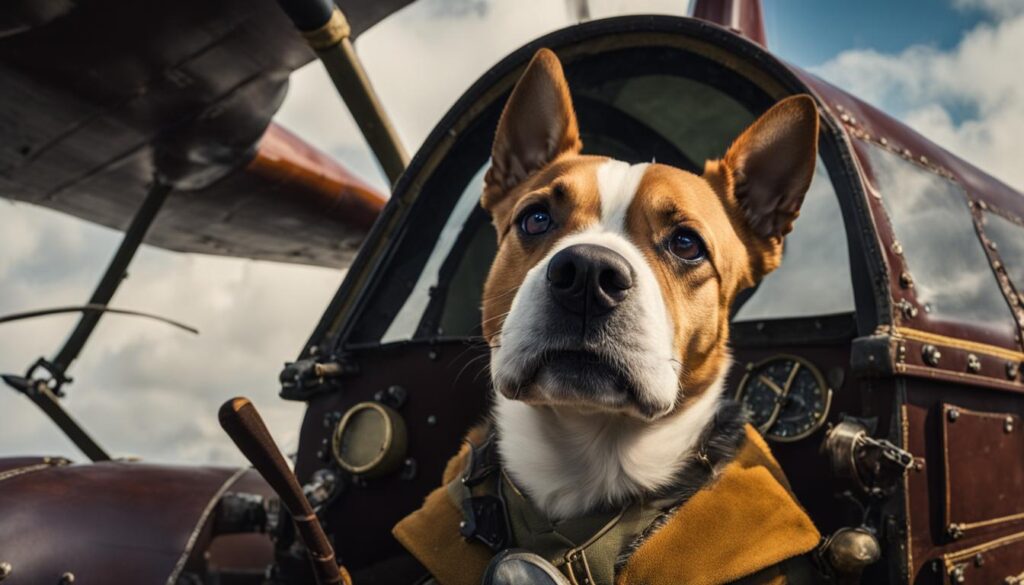
Conclusion
As we conclude our exploration of early aerial travel, it becomes clear that dogs played a pivotal role in this historic era. From their humble beginnings, dogs accompanied early aviators, providing invaluable assistance and unwavering support. Their unseen contributions cannot be overstated.
Canines in historic air travel served as more than just companions; they were navigators, rescue helpers, and sources of comfort during challenging flights. Their unique abilities and unwavering loyalty made them indispensable in the skies.
These early aviation dogs went through rigorous training, honing their skills for the important tasks at hand. Breeds with qualities such as focus, agility, and obedience were specifically chosen, ensuring they were well-equipped for their roles as they accompanied aviators on their flights.
While technology may have evolved over time, the importance of dogs in aerial rescue operations remained constant. They adapted and worked alongside human rescuers, showcasing their intelligence and dedication in locating and saving lives.
As we look back on this era, we must acknowledge the challenges faced by early aviation dog handlers. From the financial burden of training and maintenance to the physical and emotional toll of the work itself, these individuals displayed an unwavering commitment to their four-legged companions and the lives they sought to protect.
In conclusion, dogs in early 20th-century flights played an integral part in the success and safety of aviation. Their skills, dedication, and loyalty were instrumental in shaping the history of early aerial travel. Without their unseen efforts, this era would have been far more dangerous and less successful. The legacy of these canines in historic air travel is a testament to their unique abilities and the special bond they shared with the aviators they accompanied.
FAQ
What role did dogs play in early aerial travel?
Dogs played a crucial role in early aerial travel, providing assistance and support to aviators during the early 20th century. They served as companions, navigators, and even rescue helpers.
Why were dogs chosen to accompany early aviators on their flights?
Dogs were chosen for their unique abilities, including their calming presence, navigational skills, and assistance in search and rescue missions. They provided support and ensured the safety and success of early flights.
How were dogs trained for their roles in early aviation?
Dogs selected for early aviation roles underwent intensive training to develop the necessary skills. Breeds with herding, hunting, or working backgrounds were often chosen for their agility, focus, obedience, and love of work.
How did the role of dogs in aerial rescue evolve over time?
As technology advanced, new methods for locating and rescuing individuals were developed. Dogs continued to play an important part in these efforts, adapting to changing circumstances and working alongside human rescuers.
What challenges did early aviation dog handlers face?
Early aviation dog handlers faced challenges such as the cost of training and maintaining their dogs, as well as the physical and emotional toll of the work itself. However, their dedication and commitment to saving lives remained unwavering.
What would early aviation have been like without dogs?
Without the unseen efforts of dogs in early aerial travel, flights would have been far more dangerous and less successful. Dogs played an essential role in providing vital support to aviators and assisting in search and rescue operations.

